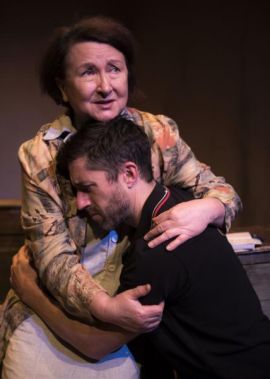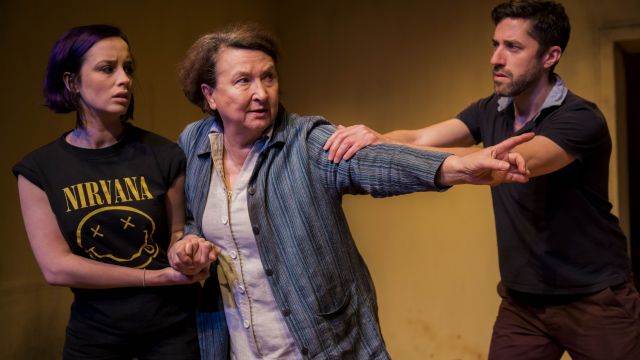The Honey Bees
There’s much to enjoy in Lewis’s new play, developed with the help of Red Stitch’s INK…a worthy in house programme for writers which is in jeopardy after Arts Funding cuts. It’s part Outback Chekhov/part Home and Away in red Dirt, but, despite being an entertaining 90 minutes, the text itself needs a solid dose of subtext and less exposition, more depth and less width, more character and less plot. It simultaneously feels too long, and yet doesn’t allow enough breathing space for us to take in the machinations between characters. It’s also crying out to be opened up – to feel the emptiness around that old house. Some plays work brilliantly at Red Stitch in their tiny theatre, some not so well, despite the red dirt floor and the fascinating sound-scape of buzzing (almost imperceptible but always there) by Daniel Nixon. Conversely, Daniel Anderson’s lighting seems too soft, too diffused. The harshness of Western Australian light sears the soul as well as the eyes.
The background however is an interesting one – a remote homestead in WA, amidst the red earth, that used to be the centre for a thriving honey business, millions of bees from healthy stock. But now, to help with falling finances, Matriarch Joan has been persuaded by prodigal son Darryl to sell 6 million bees (who counts them, I wonder?) if they can just get them on the plane in time. They will replenish stocks in the United States that have all died off, victims to a parasitic mite. But is it already too late for the bees and the family?

Despite this interesting background setting, The Honey Bees is another drama about Family Dysfunction …because that’s where most of life happens. Lewis continues the bees as a metaphor for the family, with Polish born matriarch Joan very much the queen, with workers and drones and scouts around her in the form of her children. When a new, potential, queen arrives suddenly, it should totally throw the hive into complete disarray, with the queen, now old, losing her power …but it doesn’t entirely work. Still, the constant idea of the bees, and characters dressed in protective suits with smoke guns, is certainly new to us as theatre-goers.
The cast is strong, as always with Red Stitch, but the honours go to the youngest and oldest members of the cast. Eva Seymour is this year’s talented graduate member for Red Stitch. She is vibrant and mesmerising on stage, completely embodying the young Melissa, a city girl with a chip on her shoulder, who comes back to either embrace or destroy the family she has never had – even the character seems unsure of her motives, which adds to the intrigue. She is certainly a young actor who has already found her own truth, and who knows how far she can go? I’ll await her next role with interest.
Marta Kaczmarek (Matriarch Joan) is simply amazing…and here I must disclose that Marta has been a dear friend for over 15 years. It doesn’t matter. She would be excellent even if I had never seen her before, and if she wasn’t I would most certainly say so. She brings a wealth of experience, nuance, depth and understanding not just to the words, but to the emotions behind them. She makes Joan both stoic/hard, and fragile/vulnerable, a truly complex woman capable of paradoxes. She is both selfish and selfless and every action is for the good of the hive…and herself. Joan becomes a fascinating character in Kaczmarek’s hands. She also find the laughs to break up the melodrama: sometimes it’s in a gesture, or a sideways glance, an expression, a shift in body language. It’s largely due to her that the play comes to life at all.
Daughter Clover Rebecca Bower) and her long time lover Kerrie (Katerina Kotsonis) have a nicely developed relationship which is poignant, but could use more depth. Both actresses are excellent.
 Despite the rest of the cast being female (or perhaps because of it) Christopher Brown’s portrayal of wayward son Darryl feels undercooked and unconvincing. But it may be that Director Ella Caldwell has made this a conscious decision, to compound the character’s alienation from the family. Still one wonders, after Darryl tries to get off with Melissa, the strange girl from the city, why he doesn’t react when he discovers his true connection to her….or why Melissa behaves as she does when she knows the truth all along?
Despite the rest of the cast being female (or perhaps because of it) Christopher Brown’s portrayal of wayward son Darryl feels undercooked and unconvincing. But it may be that Director Ella Caldwell has made this a conscious decision, to compound the character’s alienation from the family. Still one wonders, after Darryl tries to get off with Melissa, the strange girl from the city, why he doesn’t react when he discovers his true connection to her….or why Melissa behaves as she does when she knows the truth all along?
Despite its problems, The Honey Bees is worth seeing. It’s a world premiere and will no doubt work itself in over the run. Having said that, I can’t help but think the playwright is writing for the wrong medium. There’s a terrific screenplay here waiting too be explored and realised. The visuals are already there between the lines – endless miles of white hives against Red Earth and piercing blue sky, the old homestead and barn becoming skeletal with decay. I’d urge Lewis to keep working on his play, but to also expand his vision for the screen. We need new Australian plays, but we also need good Australian films which are our own, yet speak to the rest of the world, and the decimation of the world’s bees is an important issue.
Coral Drouyn
Images (from top): Eva Seymour, Marta Kaczmarek and Christopher Brown, Marta Kaczmarek and Christopher Brown, & Katerina Kotsonis and Rebecca Bower. Photographer; Jodie Hutchinson.
Subscribe to our E-Newsletter, buy our latest print edition or find a Performing Arts book at Book Nook.

